Garden diseases - Potato and tomato blight
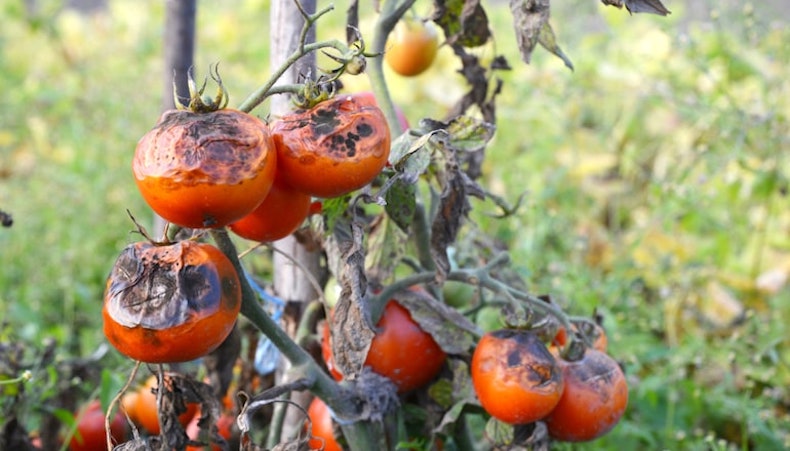
Late blight can be devastating for tomatoes and potatoes
Image: Radovan1/Shutterstock
Late blight, a fungal infection more commonly known as potato and tomato blight, damages the leaves and crops of potato and tomato plants. Once infected, the entire plant may need to be removed, and carefully disposed of, to protect other plants from contagion.
What is potato and tomato blight?
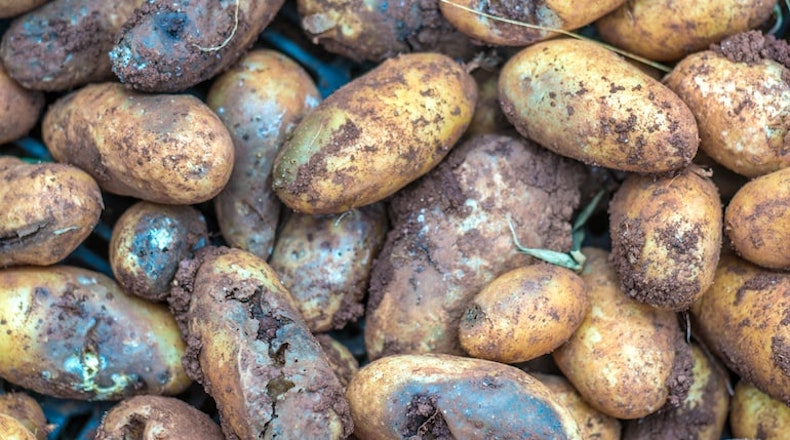
Potato blight can spread rapidly if left undetected
Image: Thy/Shutterstock
Potato and tomato blight is a disease caused by a microscopic fungus-like organism. It’s spread via wind-blown structures that release their spores into water, making the problem worse during wet and humid summers. The pathogen can overwinter in rotten potatoes that have been left in the ground, so grow bags are a great way to avoid this.
Once the leaf tissue of a plant is infected, the disease spreads rapidly. Early attacks can ruin an entire potato crop as the leaves shrivel and die. However if blight occurs after the potato tubers have set, harvesting your crop early can sometimes save it.
Tomatoes grown in greenhouses are less susceptible. However if the disease does find its way into your greenhouse, the humid conditions will cause it to spread and progress very quickly.
How to recognise potato and tomato blight
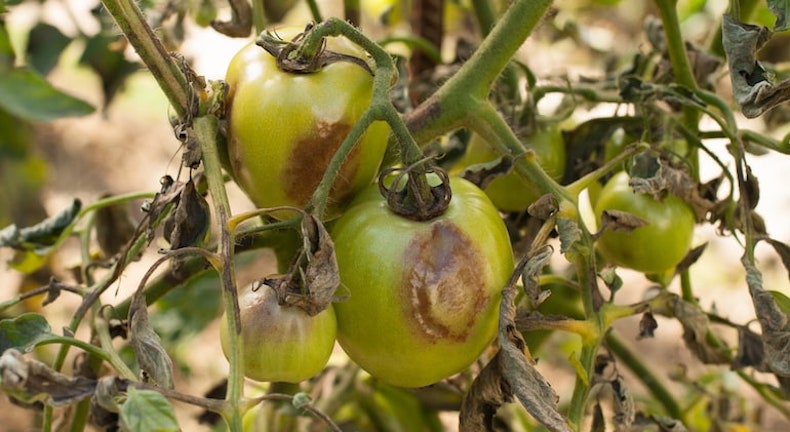
Keep an eye out for brown patches on new green tomatoes
Image: Elena Masiutkina/Shutterstock
The leaves of potato and tomato plants are the first to show signs of the disease - shrivelling and turning brown. Humidity makes the problem worse, and during such conditions you might notice white fungal growth on the underside of leaves and brown lesions on the stems.
In potato plants, tubers will develop a soft rot, often appearing as a reddish layer of decay just beneath the skin.
In tomatoes you will notice that nearly ripe fruits will suddenly decay, and new green fruit will develop brown patches.
How to treat potato and tomato blight
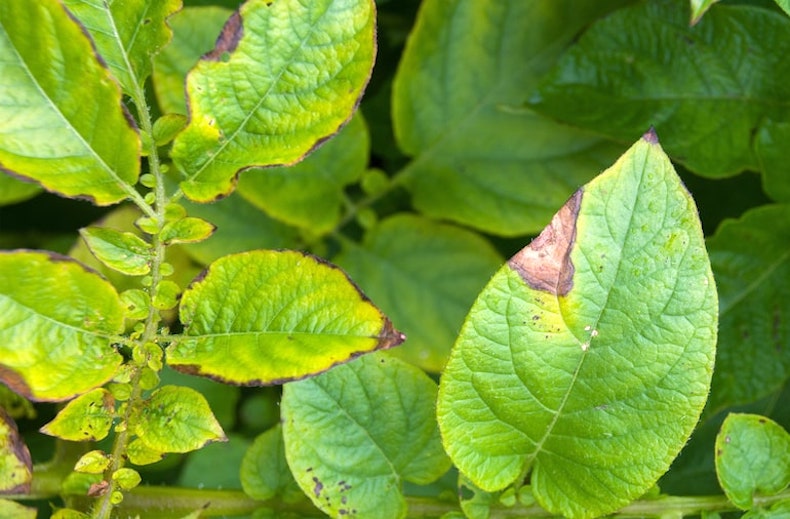
Picking off infected leaves can slow the progress of late blight
Image: Phil Darby/Shutterstock
Should you notice signs of blight in your tomato or potato plants, pick off any infected leaves immediately to slow down the progress of the disease.
There is no treatment for tomato plants once they succumb to blight. As soon as the disease reaches the fruits, the plants will need to be removed.
Once more than 25% of your potato plants are infected with blight, you’ll need to cut off the foliage to soil level and destroy it. Wait for a few weeks to allow the skin on the potatoes to harden before digging them up – the tubers should be checked regularly for decay, and those that appear fine should be used quickly.
You’ll need to burn all the affected material, or bury it more than 45cm under the ground, as a compost heap will just keep the infection in your garden.
Monitor the Fight Against Blight website, which provides early warning of outbreaks in your area.
How to prevent potato and tomato blight
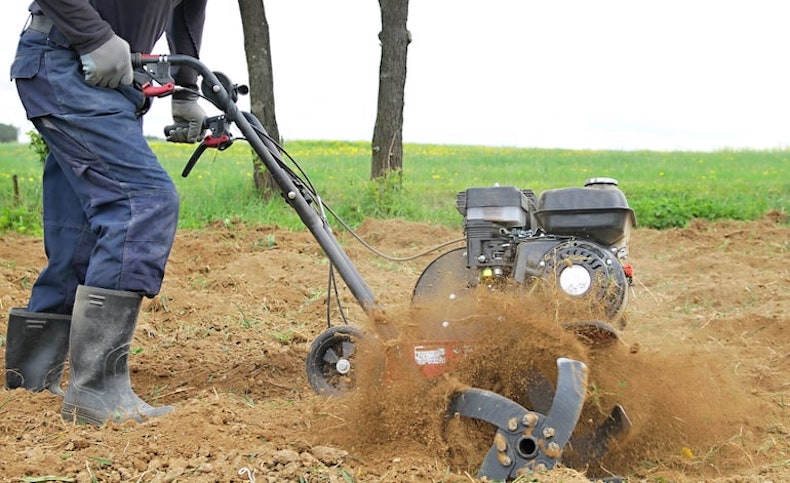
Rotating your plot before planting potatoes can minimise the chances of blight
Image: Herlanzer/Shutterstock
Choose plants and tubers from well-respected nurseries with no history of fungal infections.
Keep commercially bought tomato plants in isolation for a few weeks before planting out. If fungicides were used to suppress any infections prior to your purchase, this time should allow the underlying problems to emerge. It’s easier to prevent leaf blight, than to cure it.
Thoroughly clean your greenhouse each year to remove any overwintering spores before bringing new tomato plants in.
Give your plants plenty of space to allow for good ventilation - air circulation is vital for healthy plants and limits the humidity that fungi require to flourish.
Water plants at the base, rather than from above, to limit the amount of water on the leaves and reduce the wet conditions that fungal infections such as blight need to thrive. Water in the morning.
If planting potatoes in the ground, rotate your crop to avoid a build up of disease spores in the soil. Make sure that no potatoes from the previous season have been left behind before you plant the new crop.
Find more essential potato facts and growers' help at our hub page.
Other pages you might like
See all pests & diseases guides
Individual guides
Diseases
- Apple scab
- Bacterial canker
- Blackleg
- Blossom wilt
- Botrytis
- Brown rot
- Clematis wilt
- Downy mildew
- Fungal disease
- Honey fungus
- Leaf scorch
- Leaf spot
- Leek rust
- Lily disease
- Peach leaf curl
- Pear rust
- Phytophthora root rot
- Powdery mildew
- Silver leaf fungus
- Tomato greenback
- Tomato leaf curl
- Tomato stem canker







